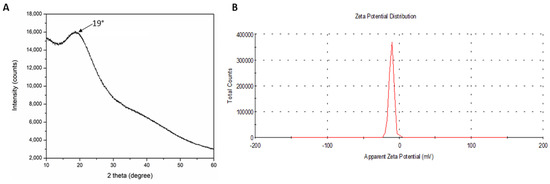Abstract
In the present work, we synthesized fluorescent carbon dots (CDs) through solvothermal treatment of Buchnania lanzan leaf extract at 160 °C for 4 h in an oven. Here, Buchnania lanzan leaves served as a renewable source of carbon. The obtained blackish brown CD solution was centrifuged, and the supernatant was filtered through a syringe filter (0.22 µm). Further, the CD solution was dried in a vacuum oven to obtain a powder. The synthesized CDs were characterized by different techniques including UV–visible spectroscopy, fluorescence spectroscopy, Fourier transform infrared (FTIR), zeta potential and X-ray diffraction (XRD). The as-prepared CD solution was found to be brownish colored in daylight while exhibiting green fluorescence under UV light. The UV–visible absorption spectrum displayed characteristic shoulder peaks of CDs at 257 nm and at 356 nm. In the fluorescence spectra, excitation-dependent emission behavior of the CDs was seen, which is one of the distinct characteristics of CDs. The negative zeta potential and characteristic peaks in FTIR suggested the presence of carbonyl, amine and hydroxyl functional groups on the CD surface. The XRD spectrum exhibited a broad peak at 2θ=19°, suggesting the amorphous nature of the CDs, similar to what has been reported in earlier works. As we synthesized surface-functionalized fluorescent carbon dots from a renewable and abundant precursor, this method can be highly useful in the large-scale synthesis of carbon dots with reduced costs and will find potential applications in the fields of drug delivery, bioimaging, etc.
1. Introduction
Carbon dots (CDs) are an emerging member of carbon nanomaterials [1]. Since their accidental discovery in 2004 [2], CDs have shown numerous potential applications as fluorescent markers, photocatalysts and biosensors, and in bioimaging, optoelectronics and drug delivery [3,4,5]. In the biomedical field, CDs have emerged as a promising candidate due to their properties such as their good aqueous solubility, biocompatibility, tunable optical properties, ease of surface modification and non-toxic nature [1,4]. The methods of CD synthesis can be roughly classified into the top-down and bottom-up approaches [6,7]. The top-down approach involves the synthesis of CDs from larger carbon materials. Methods such as laser ablation, arc discharge, chemical oxidation and electrochemical synthesis come under the top-down approach, whereas the bottom-up approach involves CD synthesis from molecular precursors, which includes methods such as microwave treatment, hydrothermal/solvothermal treatment and carbonization [1]. Until now, CDs have been synthesized from numerous precursors using the above methods. Unfortunately, most of the earlier methods involve the use of expensive and hazardous chemicals and solvents [8,9]. Therefore, the exploration of simple, economic and environmentally friendly alternate routes and starting materials focusing on the green synthesis of CDs is most desirable. In the current work, we synthesized fluorescent CDs by a simple solvothermal method using the methanolic extract of leaves of the Buchnania lanzan plant and subsequently characterized them using several techniques. Buchnania lanzan (commonly known as Chironji) is a well-known tree of the family Anacardiaceae, almost evergreen and found in the tropical deciduous forests of northern, western and central India [10,11]. The methanolic extract of Buchnania lanzan leaves is reported to be rich in carbohydrate constituents [12,13], and it serves as the carbon precursor for CD synthesis. The prepared CDs showed characteristic peaks in the UV–visible spectrum and exhibited green fluorescence under UV light. The fluorescence spectra of the CDs demonstrated excitation-dependent emission behavior. The FTIR result suggests the presence of carbonyl, amine and hydroxyl functional groups on the surface of the CDs, and the broad peak in XRD indicates the amorphous nature of the prepared CDs. The overall characterization results suggest the successful synthesis of fluorescent CDs by the solvothermal method.
2. Materials and Methods
2.1. Materials
Buchnania lanzan plant leaf extract was used as the precursor for the CDs. The methanol used for extraction was of analytical grade.
2.2. Preparation of Leaf Extract of Buchnania lanzan Plant
Fresh leaves of the Buchnania lanzan plant were collected and thoroughly washed using tap water and then milli-Q water to exclude dust particles and any unwanted foreign substances. Then, the mid ribs of the leaves were removed, and the leaves were cut into small pieces. Further, exact amounts of leaves were weighed and kept in a beaker filled with a specific volume of methanol overnight for cold maceration to take place. The macerated leaves were then crushed in a mortar and pestle and filtered to obtain the final extract.
2.3. Synthesis of CDs
The CDs were synthesized by solvothermal treatment of the obtained methanolic extract. Briefly, at first, 10 mL methanolic extract was kept inside a 25 mL Teflon-coated stainless-steel autoclave and treated for 4 h at 160 °C in an oven. Then, the whole system was cooled at room temperature, and the obtained blackish brown solution was centrifuged at 11,000 rpm for 30 min (Centrifuge 5804R, Eppendorf) to remove larger particles. The supernatant obtained in the centrifuge tube was further filtered through a syringe filter (0.22 µm) to obtain the final CD solution. The CD solution was then dried in a vacuum oven to obtain a CD powder.
2.4. Characterization Methods
The UV–visible absorption spectrum of the CDs was obtained using a Shimadzu 2450 UV–Vis spectrophotometer. The fluorescence spectrum measurement was carried out on a SpectraMax i3X, Molecular Devices, using an excitation wavelength ranging from 300 nm to 420 nm with an increase of 10 nm. The Fourier transform infrared (FTIR) spectrum of the CDs was recorded using a Shimadzu 8400s spectrophotometer. The crystal nature of the CDs was analyzed by an X-ray diffractometer. The zeta potential of the CDs was measured using Malvern Zetasizer ver.7.12.
3. Results and Discussion
The UV–visible absorption spectrum of the prepared CDs (Figure 1A) exhibited two shoulder peaks, one at about 257 nm and another at 356 nm. The first peak is assigned to the π-π* transitions of conjugated C=C bonds, while the second shoulder peak is due to the n-π* transitions of the C=O bonds in the CDs [14,15]. The CD solution when kept under UV light (365 nm) exhibited a green color, but in daylight, it was of a brownish yellow color (Figure 1B). The fluorescence spectra of the CDs are presented in Figure 2A. The fluorescence emission spectra showed strong emission, with the highest intensity peak at 450 nm under excitation at 330 nm. The further increase in the excitation wavelength gradually decreased the peak intensity, and a slight shift in the emission maxima was also observed.

Figure 1.
(A) UV–visible absorption spectrum of the prepared CDs. (B) CD solution in daylight (left) and under UV light (365 nm).

Figure 2.
(A) Fluorescence emission spectra of the CDs at different excitation wavelengths. (B) FTIR spectrum of the CDs.
Thus, an excitation-dependent fluorescence emission behavior was obtained, which is a characteristic feature of CDs and is in accordance with earlier reports [16]. To identify the surface functional groups of the CDs, FTIR spectroscopy was performed. The obtained FTIR spectrum of the CDs is presented in Figure 2B. The broad peak centered at 3313 cm−1 may be due to O-H and N-H stretching vibrations. The peaks at 2923 cm−1 and 2856 cm−1 are characteristic peaks of C-H stretching vibrations. The peak seen at 1728 cm−1 may be due to C=O stretching. The peak present at 1608 cm−1 is due to C=C stretching. The IR peak at 1210 cm−1 may be due to C-O stretching, and the peak at 1070 cm−1 is due to C-N stretching. The overall FTIR spectrum of the CDs suggests the presence of hydroxyl, carbonyl and amine functional groups on their surface.
The XRD pattern of the CDs is shown in Figure 3A. The single broad peak at approximately 2θ = 19° in the XRD pattern suggests the amorphous nature of the prepared CDs. The zeta potential (Figure 3B) of the synthesized CDs was found to be −10.6 mV. The exhibited negative zeta potential of the CDs is in accordance with the FTIR results. The negative zeta potential may be due to the hydroxyl and carbonyl functional groups on the surface of the CDs. The overall characterization results suggest the successful synthesis of fluorescent CDs from Buchnania lanzan leaf extract.

Figure 3.
(A) XRD pattern of the prepared CDs. (B) Zeta potential of the CDs.
4. Conclusions
Fluorescent CDs were successfully synthesized by solvothermal treatment of Buchnania lanzan leaf extract. The prepared CDs exhibited green fluorescence under UV light and demonstrated excitation-dependent emission behavior in the fluorescence spectra. The FTIR spectrum indicated the presence of hydroxyl, amine and carbonyl functional groups on the surface of the CDs, which could serve as an anchoring platform for drugs or other targeting molecules in drug delivery and bioimaging applications. As the CDs were prepared from a renewable (plant) source and a good fluorescence property of the prepared CDs was obtained, our synthetic scheme can be implemented for bulk production of fluorescent CDs and can be utilized in different biomedical applications.
Author Contributions
Conceptualization, P.J. and A.D.; methodology, P.J.; validation, P.J.; formal analysis, P.J.; investigation, P.J.; resources, A.D.; data curation, P.J.; writing—original draft preparation, P.J.; writing—review and editing, A.D.; visualization, A.D.; supervision, A.D.; project administration, A.D. All authors have read and agreed to the published version of the manuscript.
Funding
This research received no external funding.
Institutional Review Board Statement
Not applicable.
Informed Consent Statement
Not applicable.
Acknowledgments
The authors would like to acknowledge the Birla Institute of Technology, Mesra, Ranchi, India, for the instrumentation facility and infrastructural support. Pradip Jana would also like to acknowledge the Birla Institute of Technology, Mesra, Ranchi, India, for the Institute Research Fellowship award (Ref No. GO/Estb/Ph.D/IRF/2019-20/6649).
Conflicts of Interest
The authors declare no conflict of interest.
References
- Wang, Y.; Hu, A. Carbon quantum dots: Synthesis, properties and applications. J. Mater. Chem. C 2014, 2, 6921–6939. [Google Scholar] [CrossRef] [Green Version]
- Xu, X.; Ray, R.; Gu, Y.; Ploehn, H.J.; Gearheart, L.; Raker, K.; Scrivens, W.A. Electrophoretic Analysis and Purification of Fluorescent Single-Walled Carbon Nanotube Fragments. J. Am. Chem. Soc. 2004, 126, 12736–12737. [Google Scholar] [CrossRef] [PubMed]
- Baker, S.N.; Baker, G.A. Luminescent Carbon Nanodots: Emergent Nanolights. Angew. Chem. Int. Ed. 2010, 49, 6726–6744. [Google Scholar] [CrossRef] [PubMed]
- Hola, K.; Zhang, Y.; Wang, Y.; Giannelis, E.P.; Zboril, R.; Rogach, A.L. Carbon dots—Emerging light emitters for bioimaging, cancer therapy and optoelectronics. Nano Today 2014, 9, 590–603. [Google Scholar] [CrossRef]
- Jaleel, J.A.; Pramod, K. Artful and multifaceted applications of carbon dot in biomedicine. J. Control. Release 2018, 269, 302–321. [Google Scholar] [CrossRef] [PubMed]
- Liu, M.L.; Chen, B.B.; Li, C.M.; Huang, C.Z. Carbon dots: Synthesis, formation mechanism, fluorescence origin and sensing applications. Green Chem. 2019, 21, 449–471. [Google Scholar] [CrossRef]
- Zheng, X.T.; Ananthanarayanan, A.; Luo, K.Q.; Chen, P. Glowing graphene quantum dots and carbon dots: Properties, syntheses, and biological applications. Small 2015, 11, 1620–1636. [Google Scholar] [CrossRef] [PubMed]
- Sahu, S.; Behera, B.; Maiti, T.K.; Mohapatra, S. Simple one-step synthesis of highly luminescent carbon dots from orange juice: Application as excellent bio-imaging agents. Chem. Commun. 2012, 48, 8835–8837. [Google Scholar] [CrossRef] [PubMed]
- Yang, Y.; Cui, J.; Zheng, M.; Hu, C.; Tan, S.; Xiao, Y.; Yang, Q.; Liu, Y. One-step synthesis of amino-functionalized fluorescent carbon nanoparticles by hydrothermal carbonization of chitosan. Chem. Commun. 2012, 48, 380–382. [Google Scholar] [CrossRef] [PubMed]
- Khatoon, N.; Gupta, R.K.; Tyagi, Y.K. Nutraceutical potential and phytochemical screening of Buchanania lanzan, an underutilized exotic Indian nut and its use as a source of functional food. J. Pharmacogn. Phytochem. 2015, 4, 87–94. [Google Scholar]
- Banerjee, S.; Bandyopadhyay, A. Buchanania lanzan spreng: A veritable storehouse of phytomedicines. Asian J. Pharm. Clin. Res. 2015, 8, 18–22. [Google Scholar]
- Mehta, S.K.; Mukherjee, S.; Jaiprakash, B. Preliminary phytochemical investigation on leaves of Buchanania lanzan (chironji). Int. J. Pharm. Sci. Rev. Res. 2010, 3, 55–59. [Google Scholar]
- Niratker, C.; Sailaja, D. Preliminary phytochemical screening and evaluation of antimicrobial activity of Buchnania lanzan (chironji) from Chhattisgarh. World J. Pharmaceu. Res. 2014, 3, 514–522. [Google Scholar]
- Souza, D.R.D.S.; Caminhas, L.D.; de Mesquita, J.P.; Pereira, F. Luminescent carbon dots obtained from cellulose. Mater. Chem. Phys. 2018, 203, 148–155. [Google Scholar] [CrossRef]
- Song, P.; Zhang, L.; Long, H.; Meng, M.; Liu, T.; Yin, Y.; Xi, R. A multianalyte fluorescent carbon dots sensing system constructed based on specific recognition of Fe(iii) ions. RSC Adv. 2017, 7, 28637–28646. [Google Scholar] [CrossRef] [Green Version]
- Sun, Y.-P.; Zhou, B.; Lin, Y.; Wang, W.; Fernando, K.S.; Pathak, P.; Meziani, M.J.; Harruff, B.A.; Wang, X.; Wang, H. Quantum-Sized Carbon Dots for Bright and Colorful Photoluminescence. J. Am. Chem. Soc. 2006, 128, 7756–7757. [Google Scholar] [CrossRef] [PubMed]
Publisher’s Note: MDPI stays neutral with regard to jurisdictional claims in published maps and institutional affiliations. |
© 2021 by the authors. Licensee MDPI, Basel, Switzerland. This article is an open access article distributed under the terms and conditions of the Creative Commons Attribution (CC BY) license (https://creativecommons.org/licenses/by/4.0/).